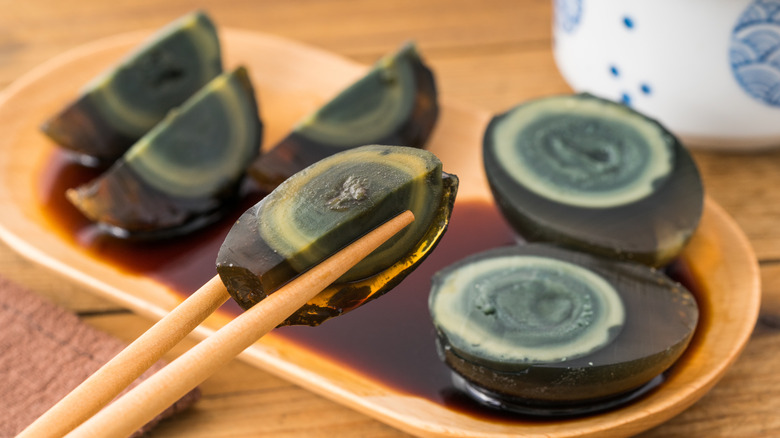You Can Actually Make Century Eggs In The Comfort Of Your Home
Given how a century egg amplifies the taste of congee or tofu and makes it more luxurious, it's a pity these delicacies are not more entrenched in the English language. We could be using phrases like "the century egg on the congee," the same way we say "the icing on the cake." Alas.
Century eggs go by a few names, like millennium eggs or black eggs, and can be made from duck, chicken, or quail eggs. They are considered a delicacy in China, Hong Kong, Taiwan, and parts of Southeast Asia, where they have long been a part of the cuisine. Traditionally, century eggs are the result of curing raw eggs in a paste of salt, quick lime, and ash and then rolling them in rice husks so they won't stick together. MasterClass suggests that sometimes the paste might include strong black tea too and it typically takes a month or two to cure (not a century).
When cracked open, the egg whites look like dark brown jelly while the yolk has a grey-green color with a creamy consistency. It does not have to be cooked or boiled and the freshly peeled egg should taste salty and savory, with a mildly pungent, fermented aroma. Contrary to popular belief, it should not smell or taste like rotting eggs.
Making century eggs is essentially a science experiment
The way the egg is transformed with a few key ingredients over time shows it is an interesting chemical experiment. Goldthread has a detailed scientific explanation for this. The paste that encases the egg is essentially an alkaline mixture, which breaks down the egg's protein into glucose and amino acids. When the two chemicals react, it is the Maillard reaction, a kind of "natural browning," which produces the distinct color of century eggs. It is the same reaction that causes toasted bread to darken. This chemical process also breaks down some of the proteins and fats into smaller, complex flavors.
As for the mud or clay casing, it serves two purposes: it creates a vacuum seal to keep bacteria or other microorganisms out and prevents oxidation. By understanding the what and why of how century eggs come to be, you can make them in your home using two possible options. Firstly, you can stay as close as possible to the traditional ingredients. Option two is to break out those protective gloves and household chemicals and experiment with some "food science."
Ways to make century eggs
Using option one, mix rice hulls, clay ash, lime powder, and salt in an earthen pot. Place the duck eggs in the pot and cover them completely with the mixture. Cover the pot and place it in a dry, dark area for six to eight weeks. If you do not have clay ash, use a mix of clay or wood ash.
Option two requires making a pickling solution from salt, lye (aka caustic soda), and water. Instructables has a handy guide and it involves submerging the eggs in the pickling solution for about 10 days. Remove and pat dry before encasing it in modeling clay for another two to three weeks. Since this step is to prevent oxidizing, choose clay that will not break when it's dry. This is not quite as set-and-forget as option one and involves handling a corrosive material like lye, but it is potentially more intriguing.
Always remember to rinse off any remaining dirt or debris on the eggs before consuming them. Cold water works best as hot water will affect the delicate texture of the eggs. The final step is to decide what you'd like to eat it with. As mentioned, congee is a surefire winner, but you can also chop them up and mix them into a broth with cabbage, or stuff them inside pastry dough for a treat.


